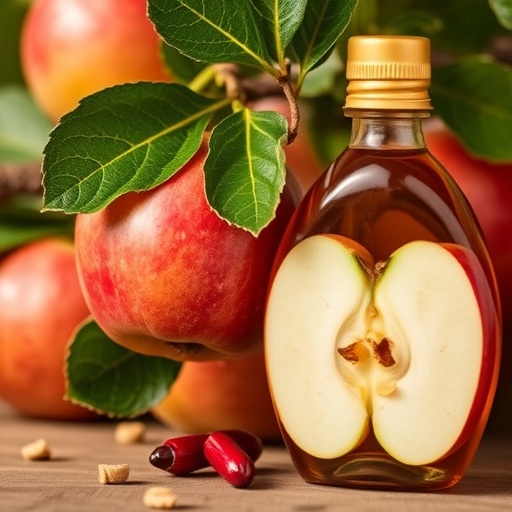
In the realm of botanical research, essential oils have emerged as a focal point of interest due to their diverse applications in medicine, food preservation, and aromatherapy. The plant species Chrysophyllum cainito, commonly known as star apple, has come under investigation due to its potential antimicrobial properties. In an insightful study, Babatunde and colleagues delve into the comparative chemical composition and antimicrobial efficacy of essential oils obtained from both the leaves and seeds of this intriguing fruit. Their findings illuminate avenues for future exploration in natural product chemistry and its potential therapeutic uses.
The study meticulously outlines the extraction procedures employed to obtain essential oils from the leaves and seeds of star apple. Utilizing hydrodistillation, the team sustained a rigorous methodology to ensure the integrity and purity of the essential oils. This technique, well-regarded in phytochemical analysis, allowed for the isolation of the volatile compounds responsible for the plant’s fragrance and potential therapeutic effects. The authors emphasize the significance of employing standardized protocols to maximize yield while minimizing degradation of the sensitive compounds that contribute to the oils’ overall efficacy.
Chemical profiling of the essential oils reveals a rich tapestry of bioactive components. Gas chromatography-mass spectrometry (GC-MS) analyses provided a comprehensive breakdown of the constituents present in both leaf and seed oils. Notable compounds identified in these oils included terpenoids, phenolics, and aldehydes, each contributing unique properties to the overall antimicrobial activity. By comparing the chemical profiles, the researchers underscore the distinct differences that may exist between oils sourced from leaves versus those derived from seeds, providing a robust basis for their subsequent antimicrobial assessments.
.adsslot_D5lg138904{width:728px !important;height:90px !important;}
@media(max-width:1199px){ .adsslot_D5lg138904{width:468px !important;height:60px !important;}
}
@media(max-width:767px){ .adsslot_D5lg138904{width:320px !important;height:50px !important;}
}
ADVERTISEMENT
Examining the antimicrobial properties of these essential oils required an extensive testing framework. The researchers employed various microbial strains to comprehensively evaluate the oils’ efficacy. Among them were both gram-positive and gram-negative bacteria, selected for their relevance in clinical settings. The study’s results revealed a surprising potency in the leaf-derived essential oil against several tested pathogens, demonstrating its capacity to inhibit bacterial growth more effectively than its seed counterpart. These promising findings could inform the development of natural antimicrobial agents, as the demand for plant-based alternatives to synthetic chemicals continues to rise.
The intriguing results of this study have broader implications within the fields of natural product research and pharmacognosy. With the world increasingly moving towards embracing green chemistry and sustainable practices, the identification of potent, naturally occurring antimicrobial compounds is critical. Essential oils, such as those derived from star apple, could serve as promising candidates for developing new therapeutic agents, particularly in light of the growing global concerns over antibiotic resistance.
Furthermore, the role of essential oils in enhancing food safety cannot be overstated. As the study suggests, the antimicrobial properties exhibited by star apple essential oils may extend beyond clinical applications, potentially offering solutions for food preservation. Natural preservatives are gaining traction in both consumer preferences and regulatory acceptance, thus underscoring the need for continued exploration of phytonutrients in our quest to ensure food security in a changing world.
Moreover, the investigation of star apple essential oils opens doors to exploring their synergistic effects with other natural compounds. The potential interaction between various phytochemicals may enhance their collective antimicrobial efficacy, presenting novel opportunities for developing multifunctional health products. The study encourages additional research into how these oils can be efficiently combined with other natural agents to maximize therapeutic benefits while minimizing adverse effects.
In the context of traditional medicine, the star apple has been utilized for its supposed health benefits for centuries. While modern scientific investigations are validating many of these traditional uses, there is still much to uncover. The rich history and cultural significance of plants like Chrysophyllum cainito serve as a compelling reminder of the wisdom embedded in indigenous practices, further motivating the scientific community to explore and document these valuable resources.
As the study illustrates, understanding the underlying mechanisms of how essential oils exert their antimicrobial effects remains a pivotal area for further research. Future investigations should delve into the molecular pathways through which these oils inhibit pathogen growth, paving the way for potential therapeutic applications. By bridging the gap between traditional knowledge and contemporary science, researchers can fully unlock the potential of these natural products.
The significance of this research extends not only to academic circles but also holds promise for the broader community, especially for those seeking natural remedies. Consumers are increasingly inclined towards holistic health solutions that promote wellness without the side effects commonly associated with synthetic drugs. This study could inspire entrepreneurs and innovators in the wellness sector to explore star apple-derived products in the marketplace, further popularizing the plant’s benefits.
In conclusion, the work of Babatunde and colleagues provides a vital contribution to the growing body of literature on phytochemicals and their applications. By elucidating the chemical composition and antimicrobial potential of essential oils from the leaves and seeds of star apple, the researchers pave the way for further exploration in both scientific research and practical applications. As interest in natural products continues to surge, studies like this one not only inform but also inspire, encouraging a budding curiosity about what other treasures nature has yet to unveil.
Expanding upon the findings of this study could yield groundbreaking developments in various fields, including pharmaceutical sciences, food technology, and holistic healing practices. The promise held by the essential oils of star apple may be just the tip of the iceberg, beckoning further inquiry into how nature’s bounty can serve the needs of humanity now and in the future.
Subject of Research: The comparative chemical composition and antimicrobial activity of essential oils from leaves and seeds of star apple (Chrysophyllum cainito).
Article Title: Comparative chemical composition and antimicrobial activity of essential oils from leaves and seeds of star apple (Chrysophyllum cainito) L.
Article References:
Babatunde, O., Yeye, E.O., Oladeji, O.S. et al. Comparative chemical composition and antimicrobial activity of essential oils from leaves and seeds of star apple (Chrysophyllum cainito L.). BMC Complement Med Ther 25, 313 (2025). https://doi.org/10.1186/s12906-025-05026-2
Image Credits: AI Generated
DOI: 10.1186/s12906-025-05026-2
Keywords: Essential oils, antimicrobial activity, star apple, Chrysophyllum cainito, phytochemistry, natural products, green chemistry, food preservation.
Tags: antimicrobial properties of Chrysophyllum cainitobioactive components in star apple oilcomparative analysis of essential oils.essential oils in food preservationfragrance compounds in botanical researchgas chromatography-mass spectrometry in essential oilshydrodistillation extraction techniquesnatural product chemistry researchphytochemical analysis of star appleplant-based antimicrobial agentsstar apple essential oiltherapeutic uses of essential oils





